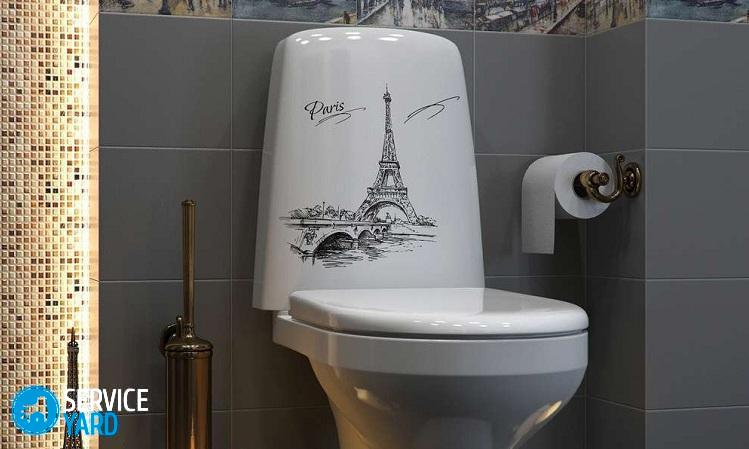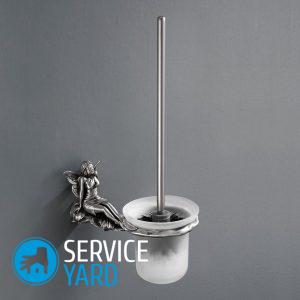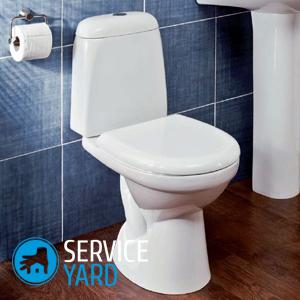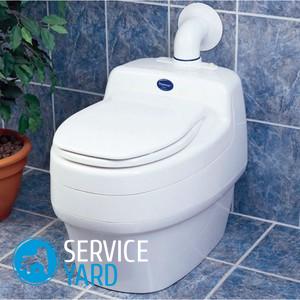Toilet bowl leaking - what to do?
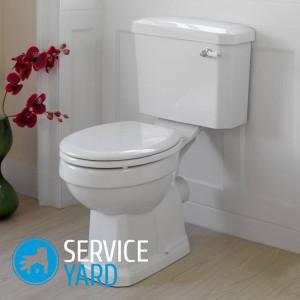
When the toilet starts to leak, few people are happy: the meter wraps up large amounts, which then need to be paid, the noise causes irritation, rust marks form on the toilet, condensation appears on the walls and pipes, which can turn into rot, mold and corrosion in the short term. To avoid such consequences, you should begin to solve the problem as soon as possible. Fortunately, most cases when a toilet bowl leaks, what to do - you can deal with them yourself. Now you will see this.
to contents ↑Device
To begin with, I would like to consider the design. The work of the toilet tank is built on the principle of a water seal. The drain mechanism includes the following:
- Rubber valve.
- Float.
- Levers.
- Traction.
Here's how it all works:
- When the button is pressed, the lever system raises the valve and opens the drain hole.
- Water descends from the tank into the toilet, while flushing everything that is intended to be lowered into the sewer.
- After flushing, the valve returns to its place, the hole closes.
- After that, filling with new fluid begins. Water is supplied until the float closes the supply opening with a shut-off valve.
- Now everything is ready for a new flush.
To get to the drain mechanism, you need to remove the cover located on top. It happens that she just lies on top and just enough to lift it. However, such covers are only found in older plumbing products.
In more modern variations, flush buttons are built into the lids, in this case, to understand why water leaks, you need to do several manipulations:
- Remove the button and the decorative ring. To do this, either twist the ring counterclockwise, or pry it with something.
- Remove the button. Usually it snaps to the lever. But sometimes it is fixed by some kind of fasteners. In this case, you have to unscrew them.
Important! The lid must be handled very carefully, as it comes in a common kit. If it cracks or breaks, finding the same one will be very problematic. Most likely, you will have to replace the entire plumbing device. For this reason, special attention should be paid to keeping the device clean; for more details, see our articles:
In modern plumbing with two flush buttons, you need to press down both buttons in turn. In this case, you should simultaneously unscrew the cover until it makes it possible to remove the cover.
In general, all modern models have a similar structure. But still, there may be slight differences. Plumbing manufacturers are constantly trying to improve their products to the maximum. That is why, in order to start repairing a tank, it is necessary to remove its cover and understand what is the cause of the problem.
to contents ↑Common Faults
Among the possible situations, the following most often happens:
- Constantly water flows from the water supply.
- Water flows continuously into the bowl.
- Faulty buttons and levers.
- You have to press many times so that the water goes into the tank or stops flowing.
In order to understand the question of why the toilet bowl leaks, what to do, you need to find the cause of the problem. Next, we will consider each of the possible problems and how to solve it.
to contents ↑Constantly flowing water into the tank from the water supply
Most likely there is an overflow. An excess volume of liquid flows through the overflow. The following options can be noted here:
- Cracked valve (relevant only for plastic models).
- Low gasket pressure.
- Defective stud that holds the float lever. Violated float adjustment.
- Worn rubber pad.
Stud and valve
Once you find where the toilet is flowing, you can begin to troubleshoot the problem. You can do this as follows:
- Remove the top cover.
- Raise the float slightly. In this case, the water supply should stop.
- If in your mechanism the float is held on a hairpin, then it is enough to pull it lightly so that the fluid supply ceases earlier.
- If the float is held on a vertical plastic notched hairpin, you need to rearrange it several positions below. It will also provide earlier closure of the fluid supply valve.
- If these operations did not bring the desired result and water continues to flow, you will have to inspect the valve.
In older models, it happens that the fluid inlet becomes larger. This may be due to the fact that a hairpin with a float sits in it. Over time, the hairpin forms a workout. As a result, the water does not completely overlap. In this situation, you will have to completely change the valve.
Important! Going to the store for a new valve, it is advisable to take the old one with you.
Gasket
In modern models, rubber gaskets may become unusable. It is located between the pusher of the float mechanism and the water inlet. In order to inspect it, you need to remove the valve assembly:
- In newer models, it is located vertically. To remove it, you need to turn it counterclockwise.
- Retention grooves are located at the base. Pull it out and inspect the grooves. If it is worn out, it means - you have to change it.
to contents ↑Important! Unfortunately, some are not sold separately. In this case, you will either have to completely change the entire mechanism of the float, or make it yourself from a piece of rubber.
Water flows continuously into the bowl
After we figured out the float part and the constant supply of water, we will find out why the toilet bowl flows, while the water level is below the pouring hole, what to do in this situation. Here the problem may be similar - violation of tightness.
The most likely malfunction is a decrease in the pressing of the rubber valve to the pear or, as an option, some object getting under it. As mentioned earlier, it is this valve that opens the passage of fluid to the bowl. Over time, rubber may lose its elasticity, resulting in cracks and leaks.
If such a problem occurs, you will have to change this node. The pear on the lever is attached using a threaded connection. To replace, you will need to remove the entire mechanism, so unscrew it counterclockwise, and then remove it.
to contents ↑Important! Before you remove the mechanism, you need to check whether there is interference with the normal pressure of the pear to the saddle. It is likely that an object or debris has got in there and is preventing the valve from closing. Remove it and everything will fall into place.
Leaking between the toilet and the tank
In older models, the problem may arise due to the destruction of the bolts that tighten the tank and the shelf. In this case, leaks can occur both inside the bowl and outside the toilet, on the floor. Everything will depend on the design of plumbing:
- The cause may be corrosion, which adversely affects fasteners. As a result, leaks arise. This situation is solved by replacing the bolts, it is desirable that they be resistant to corrosion.
- It may also happen that the rubber seals on the bolts lose their integrity and begin to leak fluid. In this case, they will also have to be replaced.
- Another problem may appear due to the gasket, which is located between the tank and the shelf. It can be made of rubber or foam. Over time, it can dry out, which is why water can pass through. The solution is to replace the item.
Faulty button and lever system
It so happens that you can eliminate leakage in the toilet by replacing or adjusting the push-button mechanism. Here the malfunctions can be as follows:
- The button height adjuster has shifted. As a result, it turns out that the rubber valve is located slightly above the seat, so a gap is formed. The problem is fixed by adjusting the position of the button.
- The mechanism has failed. If you find out that the parts are broken, you will have to completely replace the drain valve.
Important! Going to the store, do not forget to take it for a sample.
So, we sorted out the malfunctions, now it's time to think about cleaning the bathroom, how to do it quickly, we’ll tell you in our blogs:
- Cleaning the bathroom and toilet save time.
- How to get rid of the smell in the toilet.
- Toilet cleaner freshener how to do it yourself.
Stock footage
As you can see, in order to solve the problem when the toilet bowl leaks, you first have to determine the cause of the breakdown. Then you will understand what needs to be adjusted and what will have to be changed. But in general, all options are available for self-repair, if there is a desire.



